| View previous topic :: View next topic |
| Author |
Message |
colbysmith
Joined: 02 Oct 2011
Posts: 4916
City/Region: Madison
State or Province: WI
C-Dory Year: 2009
C-Dory Model: 25 Cruiser
Vessel Name: C-Traveler
Photos: C-Traveler and Midnight-Flyer
|
 Posted: Fri Jun 30, 2023 9:06 am Post subject: Battery Charging parameters Posted: Fri Jun 30, 2023 9:06 am Post subject: Battery Charging parameters |
 |
|
| C-Travelers outboard was set up with charging to the start battery, through a 50A CB, from a point on the Yamaha 150 that looks like an electronic module with several wires running into it. Iím concerned this may be overcharging the battery as the Victron BMV714 is showing a voltage of 15.6 at higher RPMs and around 14.3 or so at idle. I can average this voltage down by placing the battery switch in both or Batt 2, thus paralleling with the regular battery chargingÖoff the alternator?. For this reason Iíve routinely switched to both after starting. However sometimes I would like to just switch to Batt 1. Does anyone know what that electronic module is for and if it should be hooked up this way to the battery? Iím wondering if it has something to do with spark controlÖ. I believe this was done by a shop the previous owner used. Colby |
|
| Back to top |
|
 |
jkidd
Joined: 23 Oct 2006
Posts: 1668
City/Region: Northern, Utah
State or Province: UT
C-Dory Year: 2007
C-Dory Model: 22 Cruiser
Vessel Name: Voyager
Photos: Voyager (JK)
|
 Posted: Fri Jun 30, 2023 10:03 am Post subject: Posted: Fri Jun 30, 2023 10:03 am Post subject: |
 |
|
Got a picture of it?
_________________
Jody Kidd
KE7WNG
Northern, Utah
 |
|
| Back to top |
|
 |
colbysmith
Joined: 02 Oct 2011
Posts: 4916
City/Region: Madison
State or Province: WI
C-Dory Year: 2009
C-Dory Model: 25 Cruiser
Vessel Name: C-Traveler
Photos: C-Traveler and Midnight-Flyer
|
 Posted: Fri Jun 30, 2023 10:54 am Post subject: Posted: Fri Jun 30, 2023 10:54 am Post subject: |
 |
|
| jkidd wrote: | | Got a picture of it? |
Not yet. |
|
| Back to top |
|
 |
thataway
Joined: 02 Nov 2003
Posts: 21354
City/Region: Pensacola
State or Province: FL
C-Dory Year: 2007
C-Dory Model: 25 Cruiser
Vessel Name: thataway
Photos: Thataway
|
 Posted: Fri Jun 30, 2023 11:12 am Post subject: Posted: Fri Jun 30, 2023 11:12 am Post subject: |
 |
|
Colby, no ACR? I have been using these for years, That way you do not have to do the battery switch. Also safer for the batteries. When you are under way, there should be a load on the house battery.
I am a bit puzzled that the charging circuit comes thru a 50 amp breaker. Normally the charging lead does not have a breaker. If the breaker trips, then open circuit to the alternator, and risk of damaging the diodes.
Outboards generally are not as well regulated as many other charging circuits and convinces, so that seeing a high voltage is not that unusual. If it persists, just add a resistive load such as turning on the navigation lights.
It is possible that the lead you have is the auxiliary charging lead, and the main charging is done thru the start battery cable--as in many outboards.
_________________
Bob Austin
Thataway
Thataway (Ex Seaweed) 2007 25 C Dory May 2018 to Oct. 2021
Thisaway 2006 22' CDory November 2011 to May 2018
Caracal 18 140 Suzuki 2007 to present
Thataway TomCat 255 150 Suzukis June 2006 thru August 2011
C Pelican; 1992, 22 Cruiser, 2002 thru 2006
Frequent Sea; 2003 C D 25, 2007 thru 2009
KA6PKB
Home port: Pensacola FL |
|
| Back to top |
|
 |
colbysmith
Joined: 02 Oct 2011
Posts: 4916
City/Region: Madison
State or Province: WI
C-Dory Year: 2009
C-Dory Model: 25 Cruiser
Vessel Name: C-Traveler
Photos: C-Traveler and Midnight-Flyer
|
 Posted: Fri Jun 30, 2023 11:57 am Post subject: Posted: Fri Jun 30, 2023 11:57 am Post subject: |
 |
|
| thataway wrote: | Colby, no ACR? I have been using these for years, That way you do not have to do the battery switch. Also safer for the batteries. When you are under way, there should be a load on the house battery.
I am a bit puzzled that the charging circuit comes thru a 50 amp breaker. Normally the charging lead does not have a breaker. If the breaker trips, then open circuit to the alternator, and risk of damaging the diodes.
Outboards generally are not as well regulated as many other charging circuits and convinces, so that seeing a high voltage is not that unusual. If it persists, just add a resistive load such as turning on the navigation lights.
It is possible that the lead you have is the auxiliary charging lead, and the main charging is done thru the start battery cable--as in many outboards. |
The main charging is thru the battery cables. But what is that aux charging lead you mention? Perhaps thatís what is going thru the 50a CB. The main battery cables go thru the main switch, which works just fine for me. (No ACR wanted.). But that one wire is just between the starter battery and via the CB to that connection on the outboard head. |
|
| Back to top |
|
 |
thataway
Joined: 02 Nov 2003
Posts: 21354
City/Region: Pensacola
State or Province: FL
C-Dory Year: 2007
C-Dory Model: 25 Cruiser
Vessel Name: thataway
Photos: Thataway
|
 Posted: Fri Jun 30, 2023 2:55 pm Post subject: Posted: Fri Jun 30, 2023 2:55 pm Post subject: |
 |
|
| Yes, it is very likely that this cable is the auxiliary charging cable. If that is the case and it is hooked up directly to your house battery (2 batteries certainly better for a well equipped C Dory 25.). If it is not the auxiliary charging cable, then you should be using an ACR. Check your engine manual to see if this is the aux charging cable. |
|
| Back to top |
|
 |
colbysmith
Joined: 02 Oct 2011
Posts: 4916
City/Region: Madison
State or Province: WI
C-Dory Year: 2009
C-Dory Model: 25 Cruiser
Vessel Name: C-Traveler
Photos: C-Traveler and Midnight-Flyer
|
 Posted: Fri Jun 30, 2023 4:26 pm Post subject: Posted: Fri Jun 30, 2023 4:26 pm Post subject: |
 |
|
An ACR just does the same thing my switch does, but automatically. The problem is, it won't allow you to chose when and which battery is being charged or used. Thus, I'll stick with my old fashioned switch. The house batteries can only be charged through their main battery cable, and chosen at the main battery switch. (1, 2, both). The separate wire I'm talking about is on the starter battery and I think I remember the previous owner said his shop wired it up this way to make sure it stayed charged.... Anyway, here are some photos of the area on the top of the Yamaha F150 I was talking about.
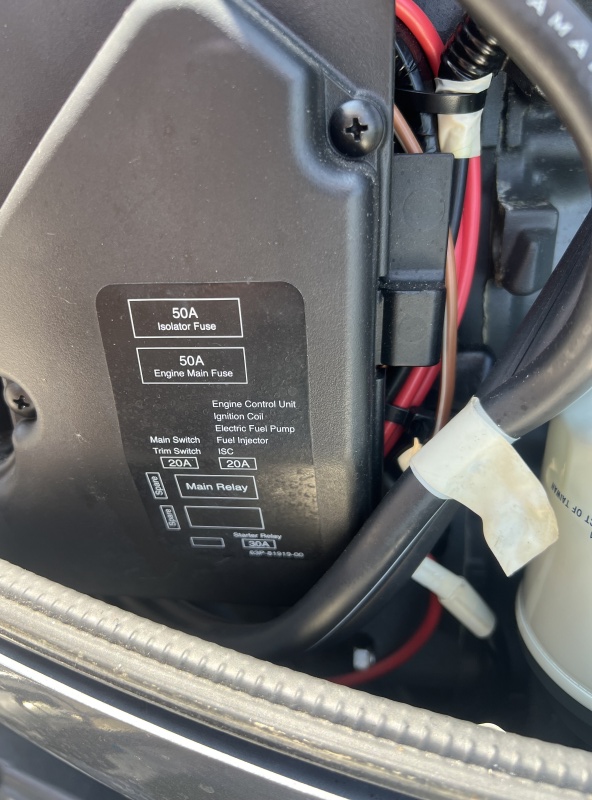
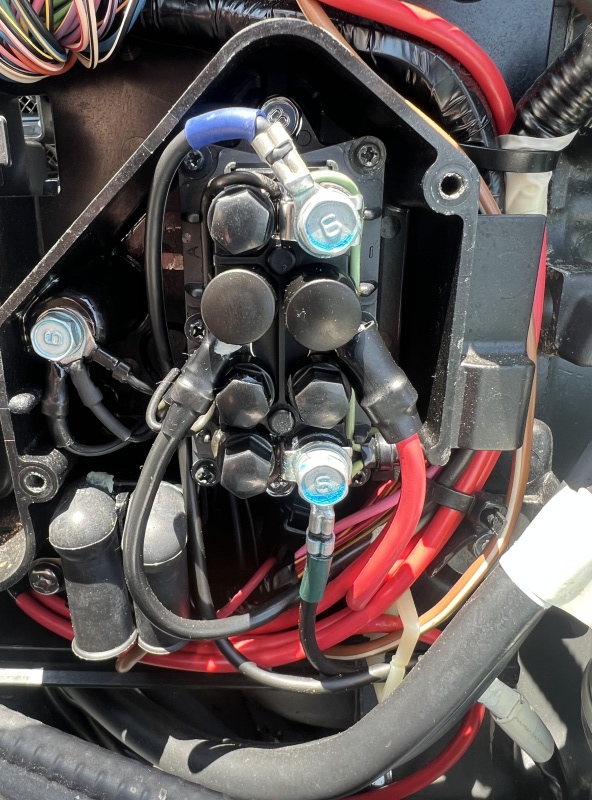
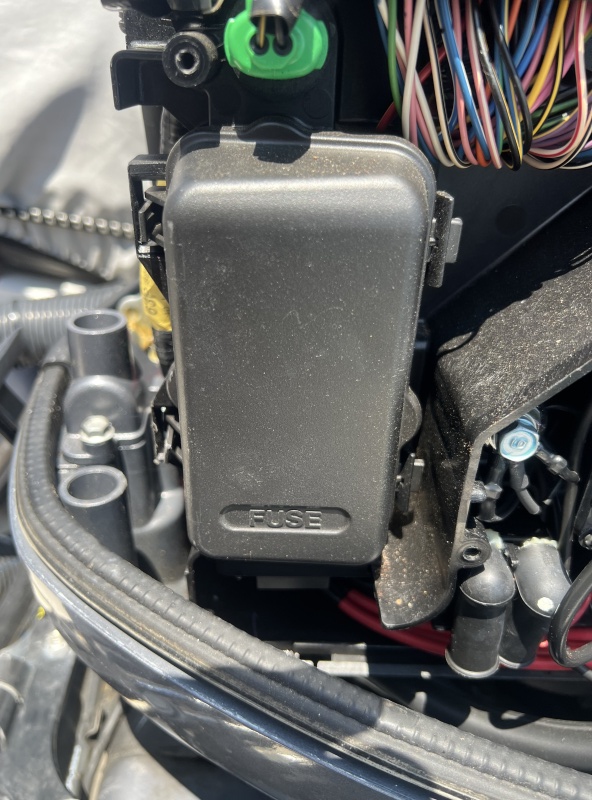
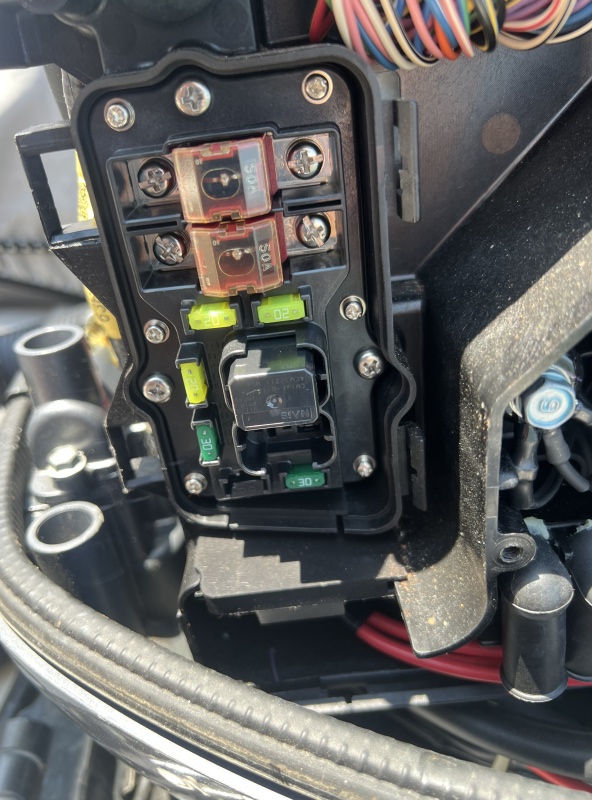
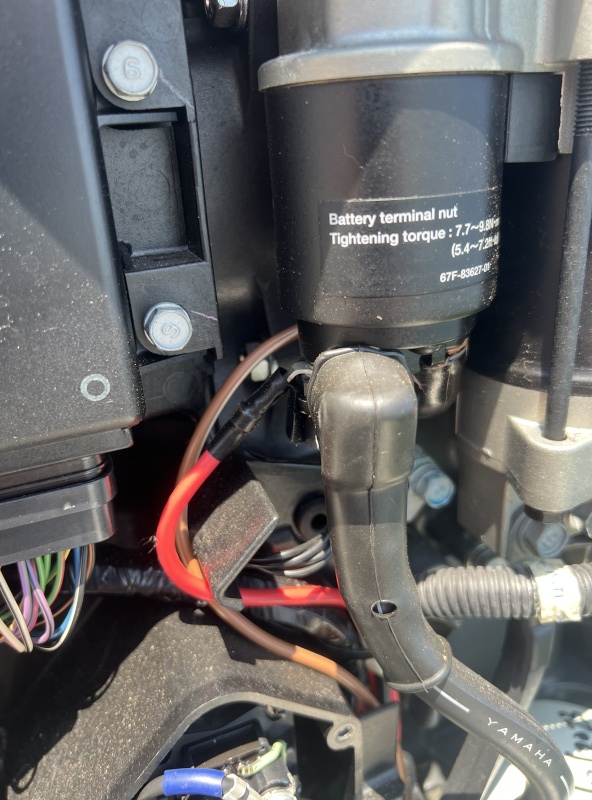
Looking at the second and fifth photos, I would need to trace the wiring again, but I'm pretty sure it is the red wire where two are hooked together on the terminal post on the second photo. That wire is coming in from the CB (8 gauge, then spliced to a 10 gauge in the front of the engine cowling), the other wire is the red one in that last photo at the starter relay. I didn't get a photo of the CB that the wire goes thru on the way to the starter battery, but it's one of those thermal CB's with the push button that pops the "arm" that can be reset, so used as a switch as well. They come with the Lewmar windlasses. Colby |
|
| Back to top |
|
 |
Robert H. Wilkinson
Joined: 26 Jan 2011
Posts: 1274
City/Region: Port Ryerse
State or Province: ON
Vessel Name: Romakeme IV
Photos: Romakeme IV
|
 Posted: Fri Jun 30, 2023 5:52 pm Post subject: Posted: Fri Jun 30, 2023 5:52 pm Post subject: |
 |
|
15.6 is in the equalization range and will boil a FLA battery dry. Keep an eye on the acid level - if it goes below the plate level it causes irreversible damage. On the plus side you shouldn't have to worry about sulfation!
Regards,
Rob
_________________
Talk to me and I will listen-- but if its not about boats or fishing all I will hear is bla,bla,bla,yada,yada,zzzzzzzz |
|
| Back to top |
|
 |
Dora~Jean
Joined: 09 Mar 2004
Posts: 1513
City/Region: Simi Valley
State or Province: CA
C-Dory Year: 2003
C-Dory Model: 25 Cruiser
Vessel Name: Dora~Jean
Photos: Dora~Jean
|
 Posted: Sat Jul 01, 2023 3:16 pm Post subject: Posted: Sat Jul 01, 2023 3:16 pm Post subject: |
 |
|
I have a separate Link 10 monitor for each starter battery which are DIRECTLY connected to their respective engine (twin Yami 80ís). I typically read 14.5-14.8VDC on each engine. Thatís just a tad higher than automobile regulators are set for (older ones at least). I believe they run outboard regulator voltages a bit higher to account for generally shorter runs than say an automobile. One of my batteries is almost 6 years old and seemed still fine even on the trip to Friday Harbor and PLI. I have a 1-2-Both switch to select which battery will be the house battery for the day (or days).
I agree with Dr. Bob, your engine should be directly connected to your start battery, not through a switch or CB. Too much risk for engine (alternator or regulator) damage.
_________________
Steve & Carmen
"Great works are performed not by strength, but perseverance" (Samuel Johnson)
Dora~Jean C-Dory 25 2002-Present
Corsair F-31 Trimaran 1996-2002
MacGregor 26X 1988-1996
Glaspar Seafair Sedan 18 (2)
StarCraft 19 & 22
Catalina 17 & 22
Crestliner 19
+4 Previous, 1/2 sail, 1/2 power |
|
| Back to top |
|
 |
rogerbum
Joined: 21 Nov 2004
Posts: 5927
City/Region: Kenmore
State or Province: WA
C-Dory Year: 2008
C-Dory Model: 255 Tomcat
Vessel Name: Meant to be
Photos: SeaDNA
|
 Posted: Sat Jul 01, 2023 9:25 pm Post subject: Posted: Sat Jul 01, 2023 9:25 pm Post subject: |
 |
|
| colbysmith wrote: | | An ACR just does the same thing my switch does, but automatically. The problem is, it won't allow you to chose when and which battery is being charged or used. Thus, I'll stick with my old fashioned switch. <stuff clipped> Colby |
I'd disagree slightly with the "problem". An ACR charges a battery when it is needed and a charging source is available. The ACR also is usually configured to prevent house loads from discharging a start battery. The advantage of the ACR is it does what it supposed to do, when it's supposed to do it and a human with a battery switch is rarely that reliable.
_________________
Roger on Meant to be |
|
| Back to top |
|
 |
colbysmith
Joined: 02 Oct 2011
Posts: 4916
City/Region: Madison
State or Province: WI
C-Dory Year: 2009
C-Dory Model: 25 Cruiser
Vessel Name: C-Traveler
Photos: C-Traveler and Midnight-Flyer
|
 Posted: Sun Jul 02, 2023 1:35 am Post subject: Posted: Sun Jul 02, 2023 1:35 am Post subject: |
 |
|
| Quote: | | The advantage of the ACR is it does what it supposed to do, when it's supposed to do it... |
Until it doesn't...  |
|
| Back to top |
|
 |
colbysmith
Joined: 02 Oct 2011
Posts: 4916
City/Region: Madison
State or Province: WI
C-Dory Year: 2009
C-Dory Model: 25 Cruiser
Vessel Name: C-Traveler
Photos: C-Traveler and Midnight-Flyer
|
 Posted: Sun Jul 02, 2023 2:10 am Post subject: Posted: Sun Jul 02, 2023 2:10 am Post subject: |
 |
|
| Doing some more internet research, it appears that the Yamaha F150 does have an auxiliary charging lead. I had not heard about that until Bob mentioned it. (Thanks Bob!) And from what I can gather, the 50 amp fuse, which happens to be close to the battery, is just protection from any current the battery can put back through the wire. I still haven't been able to find out anything as far as what voltage should be running from that aux output. So with that lead going to my starter battery, it seems like it negates the need for an ACR. My battery switch allows me to choose which battery is powering stuff, and which battery is getting charged from the outboard's main charging system. |
|
| Back to top |
|
 |
thataway
Joined: 02 Nov 2003
Posts: 21354
City/Region: Pensacola
State or Province: FL
C-Dory Year: 2007
C-Dory Model: 25 Cruiser
Vessel Name: thataway
Photos: Thataway
|
 Posted: Sun Jul 02, 2023 7:51 pm Post subject: Posted: Sun Jul 02, 2023 7:51 pm Post subject: |
 |
|
| That is correct. But beware of the infernal combustion engine. They fail. Need to have a sail or oars, just in case... |
|
| Back to top |
|
 |
|

 Search
Search Private Messages
Private Messages Profile
Profile Log in
Log in Register
Register Help
Help






